In discussing the role of zoning in urban development, it is paramount that the zoning process is first discussed to give a clue on how it is performed and executed. Another factor of much importance in the study is the challenges facing zoning as a development tool.
Introduction
Zoning is the subdivision of municipalities into small units called districts.
- It involves the regulation of buildings in each district according to their nature of construction and their usage.
- It is also the preservation of districts for certain specific usage for the general welfare of the society.
- Such functions play a major role in urban development, making zoning a major tool of development (Walters 38).
The definition is an incorporation of various definitions of zoning in existence. The overview given is majorly on its primary role as a tool for urban development.
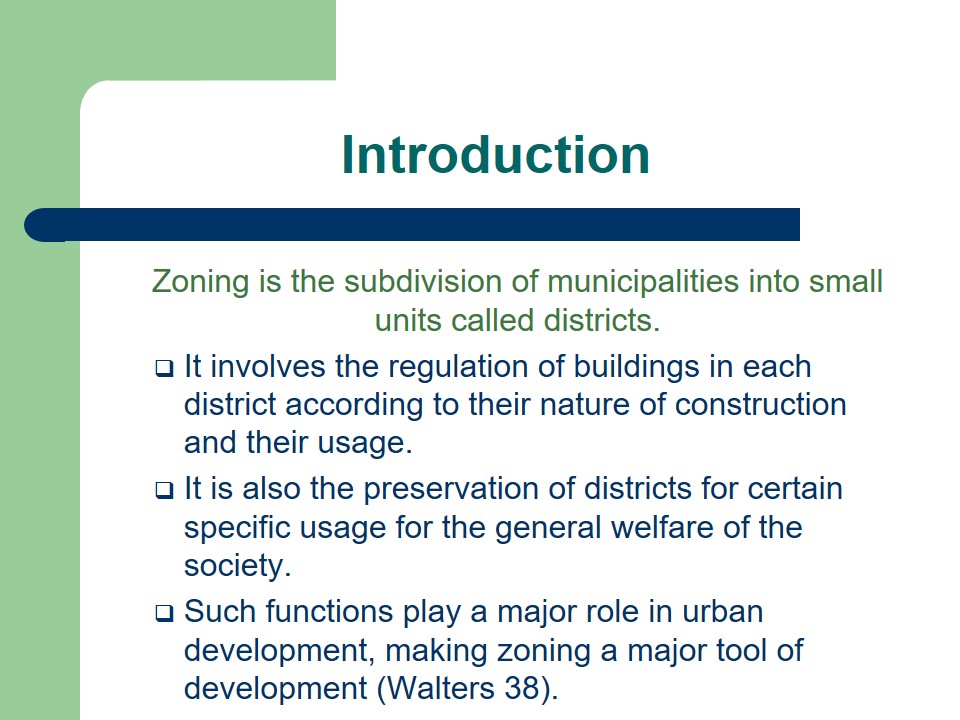
The Zoning Process
- The process of zoning calls for two public hearings;
- The planning commission,
- City council.
- The planning commission and the city council representatives collects information in as many meetings as possible.
- A new zonal area is required and it is a wise proposal to have a new one.
- All property owners within 200ft of the area under scrutiny are notified 10days in advance.
Logically, it is important that the applicant for zoning must be available during the hearings. This will enable them give out their views on their suggestions and proposals on the zoning activity.
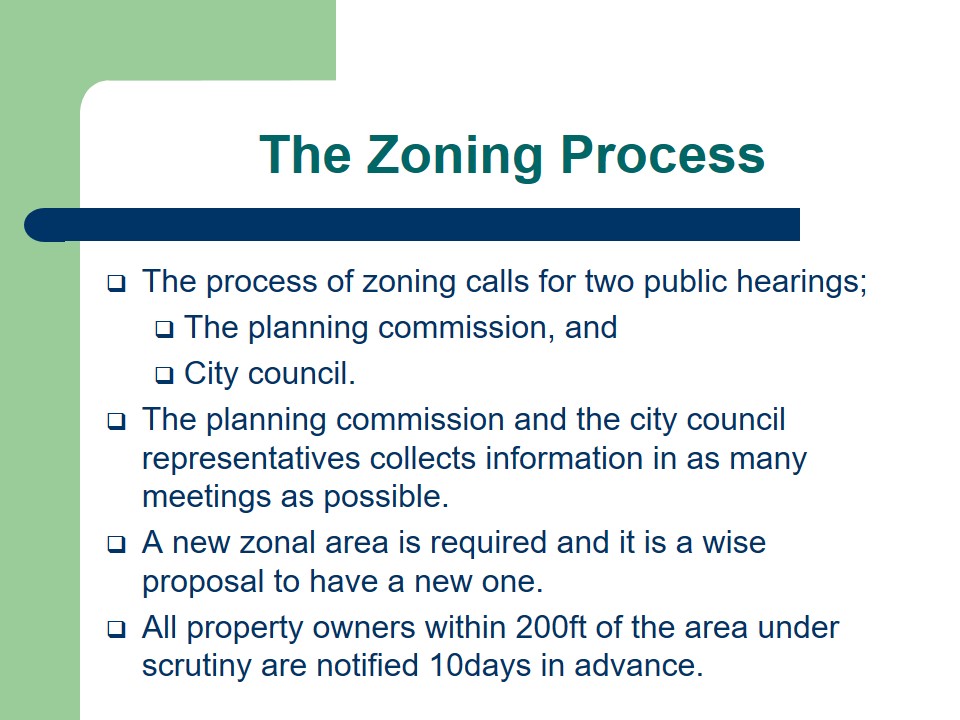
- Hearings.
- Preliminary Review.
- File Application.
- Planning Staff Review.
- Input from Other Departments.
- Environmental Review.
- Status Letter to Applicant.
- Notice of Public Hearings.
- Planning Commission Hearing.
- City Council Hearings.
This order of the zoning process was considered the most effective process with the most effective results. We also noticed that the process may vary from one county/state to another depending on various legislative rules and other legal factors. The hearing are conducted in the public to gather information on the zoning and rezoning.
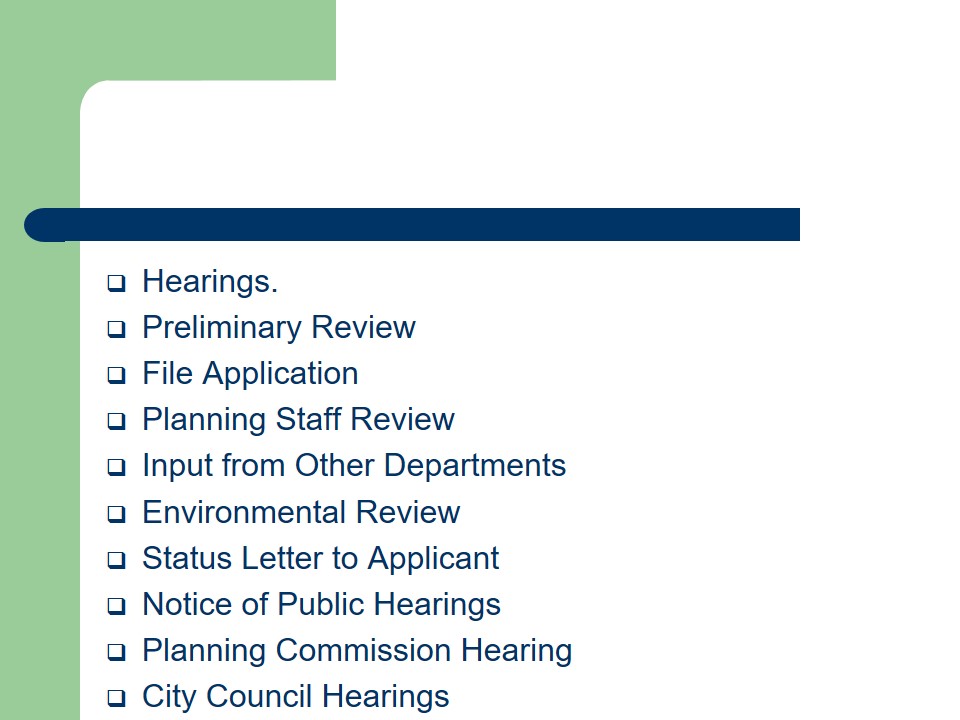
Importance of Zoning in Urban Development
- Zoning being a major tool of development, has got a very useful techniques applied to enhance urban development as discussed below.
- Most governments use it to implement land use policies.
- Zoning helps in urban development as discussed below.
The Zoning Resolution is comprehensive, but it must be flexible in order to accommodate and guide development in urban areas. It is recognized that zoning is acknowledged across the globe by planners as a major tool of urban and rural development.
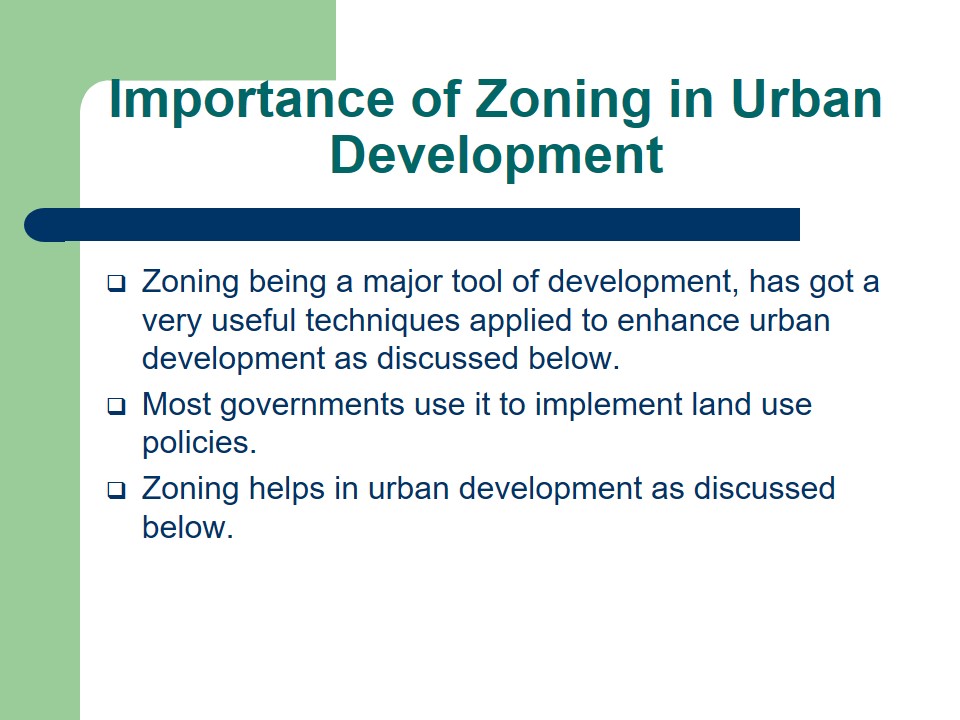
Appropriate situation of land
- Actual stating and designing land use.
- Recreational area, residential and industrial areas are well defined in the zonal area.
- Ensures maximum and appropriate use of land and space in a resourceful and ethical way.
- Zoning in ensuring this land use regulation, prevents land use conflicts.
- Most states acknowledge zoning as major tool for implementing land use plans.
It is established that zoning plays an important role in land situation and use. We established the designing of land use is to ensure that land is used for a specific purpose that suits it. In this case, safety and land productivity is maximized.
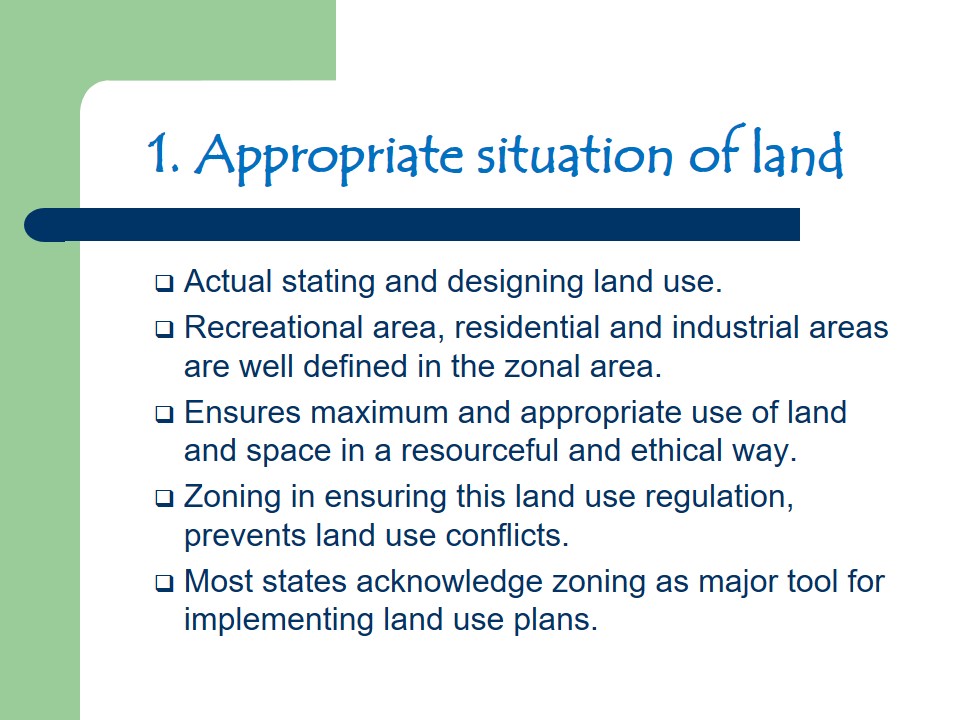
Ensure easy access to social services
- Design of streets and walkways.
- Proper location of such social services as health centers, schools, shopping centers, recreational areas and utility systems.
- Minimize traffic jam.
- Ensure efficient town with less inconveniences in acquiring social services.
- Facilitate efficient transit.
Zoning ensures efficient mobility within the town. This is achieved by the effective design of streets and walkways. This in turn facilitates transit from one point to another of the town. It also lessens traffic jam. Zoning also facilitates the proper location of such social services as schools and health centres. In this case, residents’ easy access to social services such as schools, health facilities, shopping centres and recreation areas.

Regulating the use of real property
- Restricts a particular area only for certain real estate uses.
- Residential, industrial and commercial areas are set out.
- Assesses the fitness of a certain structure to perform and fulfill particular purpose.
- It also assesses its position and if it fits the location of the proposed purpose of the structure.
- Ensures that every structure in the town is located in the correct zonal area and for the right purpose.
Zoning divides a town into various divisions for various specific uses. Lands for residential, commercial and industrial uses are well defined in a zonal region. In light to this, zoning ensures that a structure is erected in the right place for the right purpose. It also assesses the fitness of such structure to perform the intended duty.
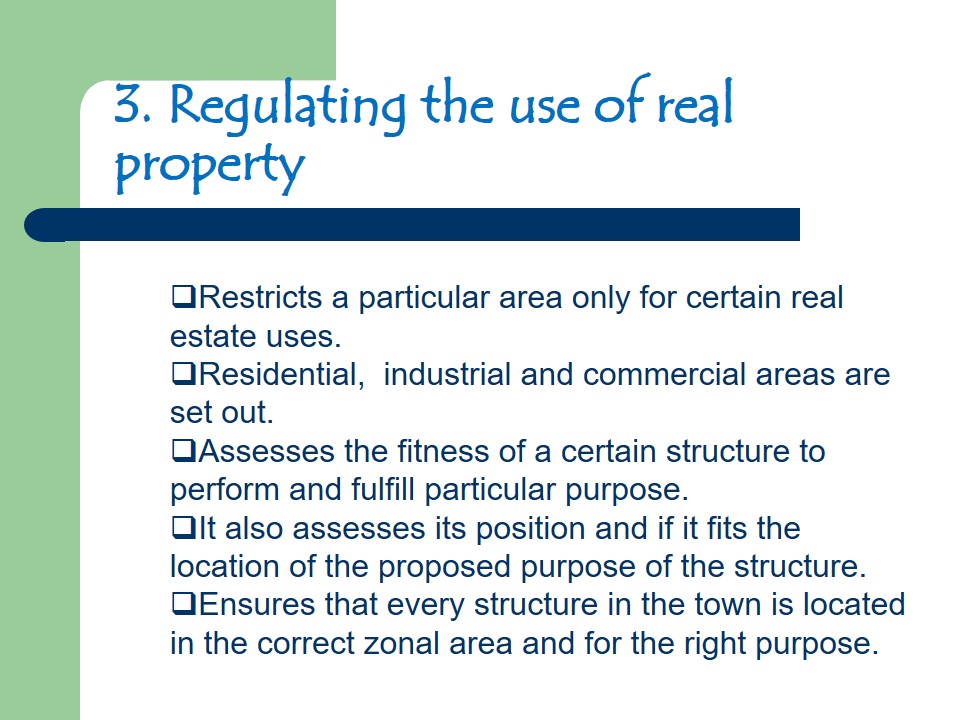
An important tool for planners
- In this case, planners take advantage of zoning by analyzing the population density.
- Having an information on the population density, planners easily come up with long term plans of sustainable development plans.
- Development plans of certain zonal areas are reached on in accordance to its population density.
- This enables the planners to come up with healthful and attractive residential areas.
Population density is an important planning tool. Planners easily access the population density of a certain area by using zonal boundaries. Once this is done, the planners will then come up with the appropriate development plans in accordance to the population and the existing developments in the area.
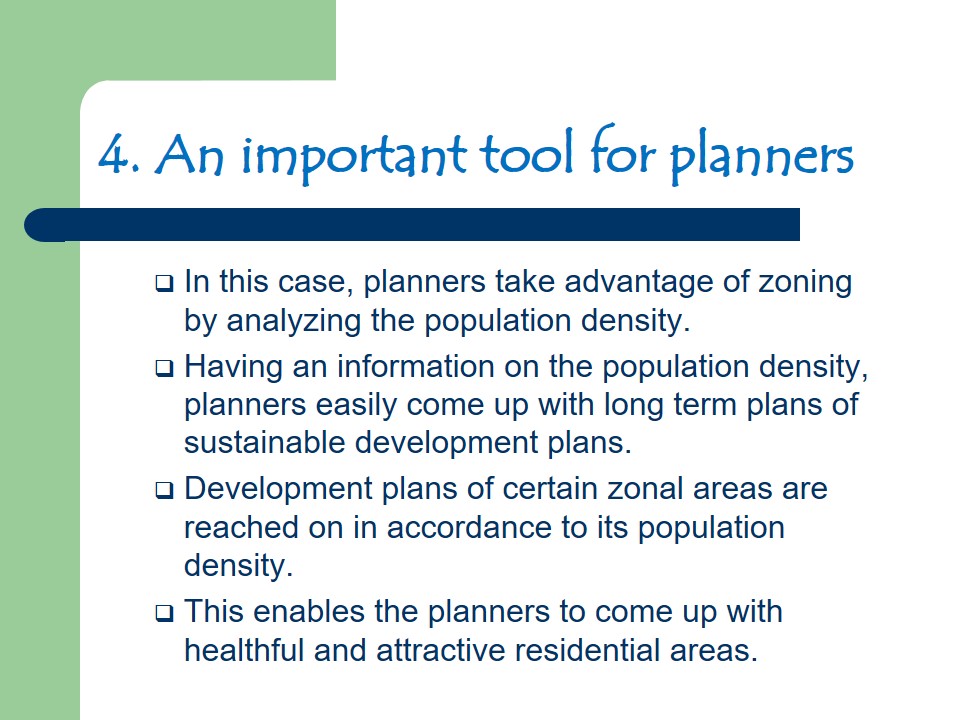
Protects farmland natural resources
- In its regulations, zoning protects farmland and natural resources as well.
- Forests, rivers and wild life are part of a town’s beatification.
- This makes a town look attractive and full of live.
- Protecting productive farms.
- Avoiding conflicting land uses.
- Maintaining a viable agricultural economic base.
- Maintaining open space/rural character.
In its regulations, zoning strives to protect natural resources and farmland as well. In ensuring that land use is appropriate and efficient, land becomes protected and farming is improved rather than when farm would be misused. In doing so, land use conflicts are minimised. Furthermore, in conjunction to land use regulation, zoning ensures that natural resources such as water bodies and forests are well taken care of, hence taking care of wild life.
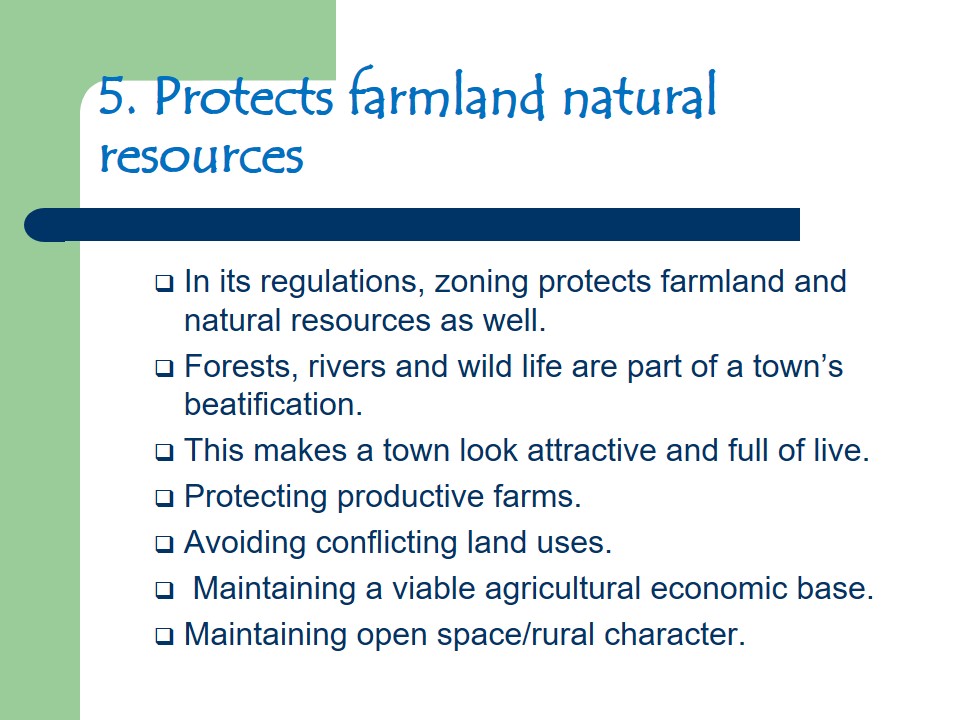
Considers future growth and developments
- Factors which are stipulated within the legislative competence of a town can be predicted by use of zoning.
- Pedestrian walkways.
- Adequate drainage system.
- Storm sewers.
- Public streets.
- All these factors can be dealt with and future expectations in their demand are projected.
Zoning is used to plan for future developments of a zonal area. Population growth rate in a certain zonal are is used to determine the kind of growth developments that may be needed in the future. Such requirements as drainage systems, storm sewers, public streets health centre facilities may have an increased demand in the future due to increased population. Therefore, zoning helps in predicting and planning for such developments.
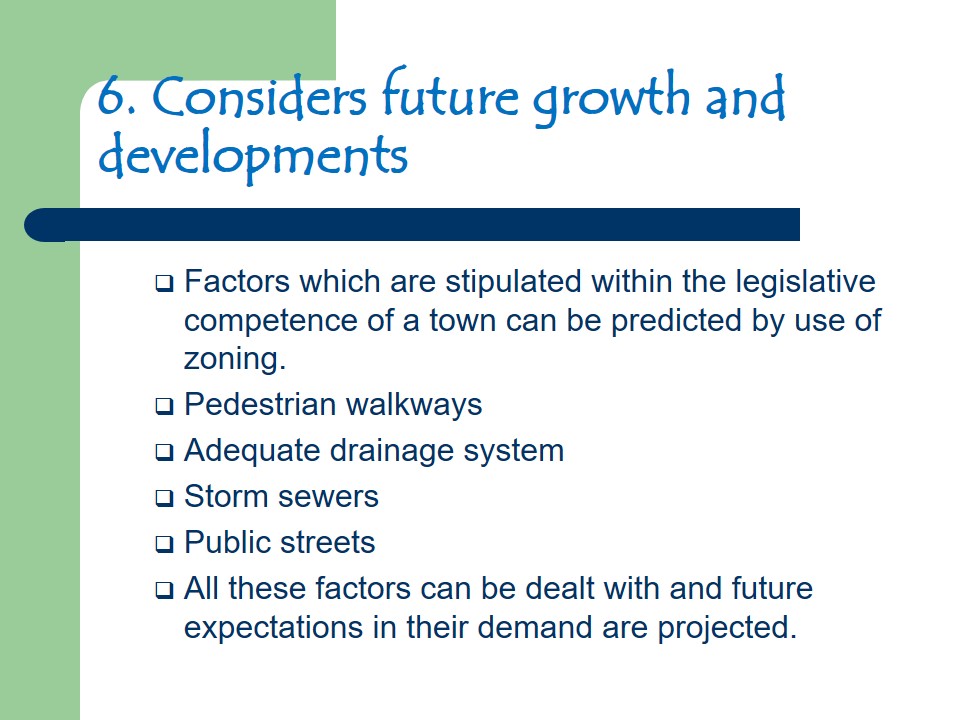
Enforcing building codes
- Whereas building codes regulate the structure and safety.
- Zoning operates side by side with building codes to stabilize the use of a building.
- Zoning is relatively permanent.
- Building codes changes from time to time to conform to new materials and technological advancements.
- This ensures that buildings conform to their intended use.
Zoning works side by side with Building Codes to enforce some regulations relating to buildings. Building codes regulates the structure and safety of a building while zoning regulates its use and location. This in general ensures the proper use of land.

Sets minimum design standards
- This ensures that new development designs meets aesthetic values.
- Ensure new structures are appropriate scale.
- It also ensures uniformity in design of a certain zonal area.
- This helps maintain design pattern which has been certified to be safe and appropriate.
Zoning sets minimum standards for design. This ensures that any new structure that should be developed in the area must meet such minimum requirements in its design. In this case, safety is considered.

Connectivity
- Zoning helps connect various places in a zonal areas.
- It is a key connecting people to access mixed uses.
- The proper situation of walkways and streets facilitate the connectivity of various places in the town.
- It facilitates walking and bicycling with traffic calming where necessary.
Zoning facilitates walking and bicycling and by the way streets are designed. It makes walking and bicycling necessary by setting the position of social services in an area connected to streets and walkways.

Zoning ordinances
- Ensuring sufficient light and air
- Efficiency of access and safety from fire.
- Safety from flood and other danger.
- Reducing or avoiding jamming in public ways.
- Ensuring proper public health.
- Ensuring adequate comfort.
- Advocating for morals and general welfare.
Zoning ordinance strives to ensure that there is sufficient lights on the streets and homesteads, and every social facility. It ensures residents are safe from fire, flood and other natural disasters. It does this by restricting developments in flood and earthquake-prone areas.
It also ensures that a proper public health is attained. This is by planning for proper sewerage delivery an disposal, adequate dumping site and proper waste disposal.
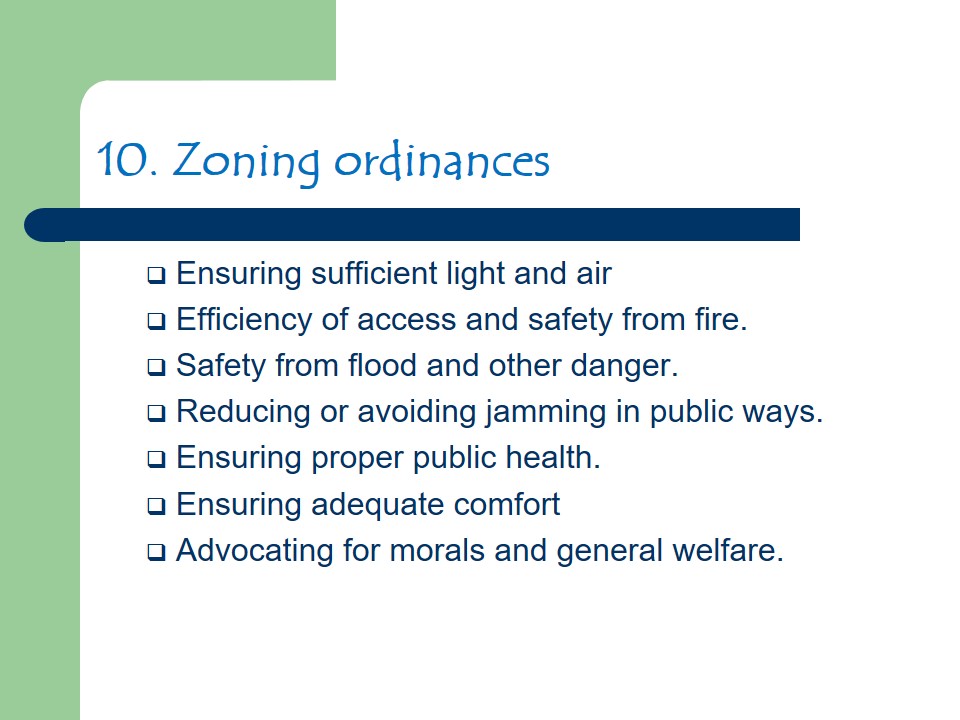
Used in density analysis
- Density is quite important since for a transit to run every half an hour, there should be almost 8 units per acres to provide enough people to justify the service.
- For a bus to run every ten minutes, there needs to be 30 units per acre.
- With more density, planners will know that the demand for services increases.
- Therefore, more shops and offices needed.
- More people walking around as well.
Density is the general population in a zonal area. It facilitates mobility since for transit to run for every certain period of time, there should be a certain minimum number of units per acre to provide enough people to justify the transit to run. High density means high demand for services and hence more people walking.
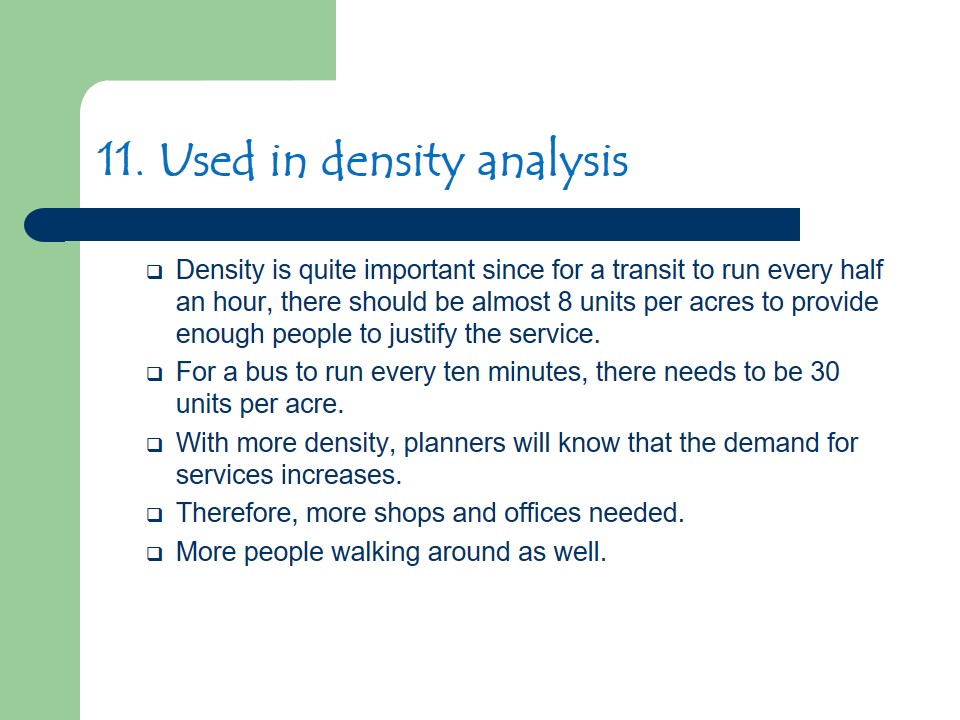
Used in Design
- In this context, design is used to mean visually pleasant, active and safe environment.
- Transit stations are safe and comfortable places.
- A mix of land uses are available promoting pedestrian, bicycle and transit usage and encouraging off-peak pedestrian activity and transit use (Burke 87).
- Buildings and services are located adjacent to the sidewalk to provide security.
Zoning helps in the design of a town. It helps come up with an aesthetic design and a safe environment. It ensures that transit stations are safe and comfortable and connects to major destinations within the town. In such a case, investores are attracted hence growth in economy.
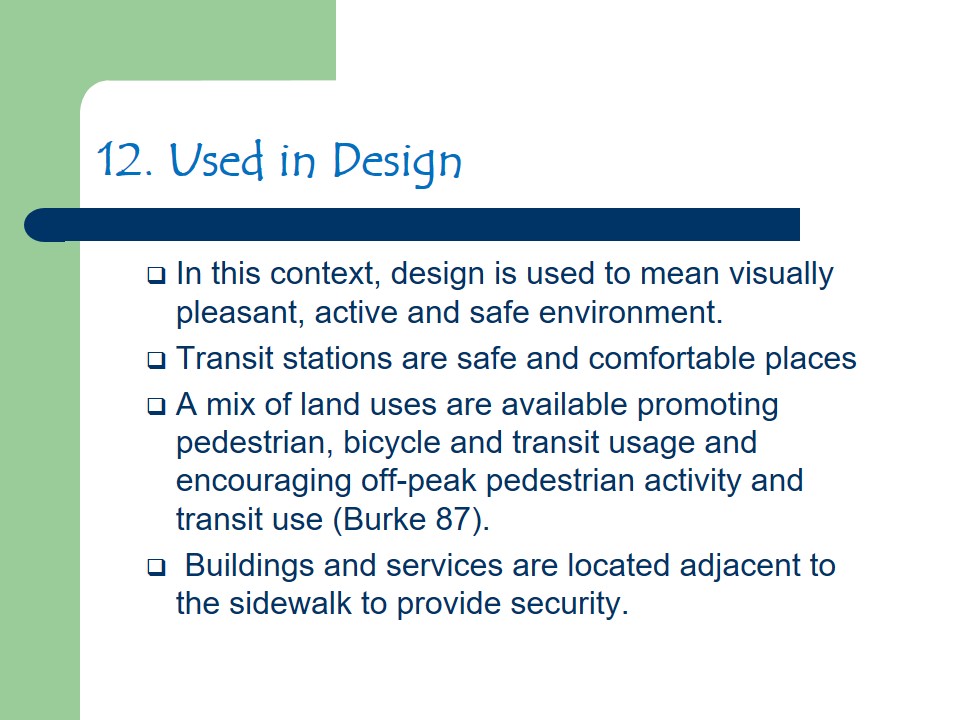
Encourage production of affordable houses
- The common characteristic of all inclusionary zoning programs is the requirement that constructors allocate a specific proportion of their development activity to “affordable” housing (Burke 92).
- For mandatory programs, it is common that builders have the alternative of paying a one-time fee rather than participating.
- Many programs are voluntary or allow significant exemptions.
Inclusionary zoning program (IZ) advocates for the development of cheap and affordable houses. This helps middle level citizens to access houses and start development projects to build an economy. This is because, affordable houses offers a great opportunity to its residents for a better economic development.
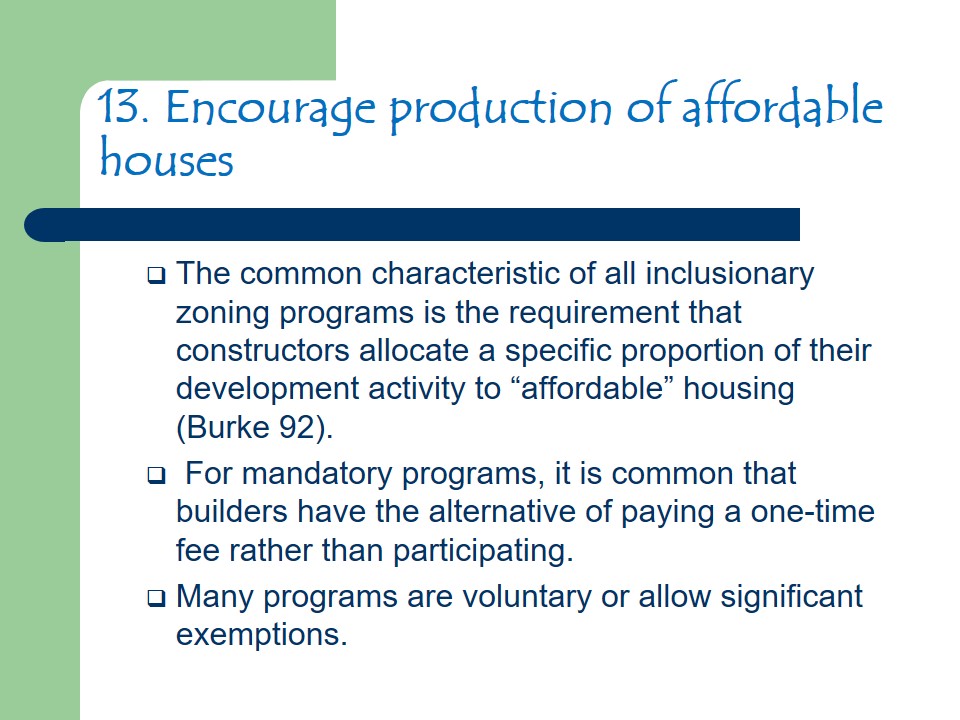
Challenges Facing Zoning as a Development Tool
- Zoning encounters some setbacks as a tool for development.
- In most cases, these setbacks hampers the anticipated development plan.
- The same setbacks lead to poor development of a town.
- Poor sewerage and drainage system.
- Poor restriction of constructing buildings in danger-prone areas such earthquake and flooding zones hence poor safety.
Zonal failures are as a result of other external factors and results to a poorly developed town/municipality. This is because zoning is not a sole entity judged with the responsibility of land use regulations.
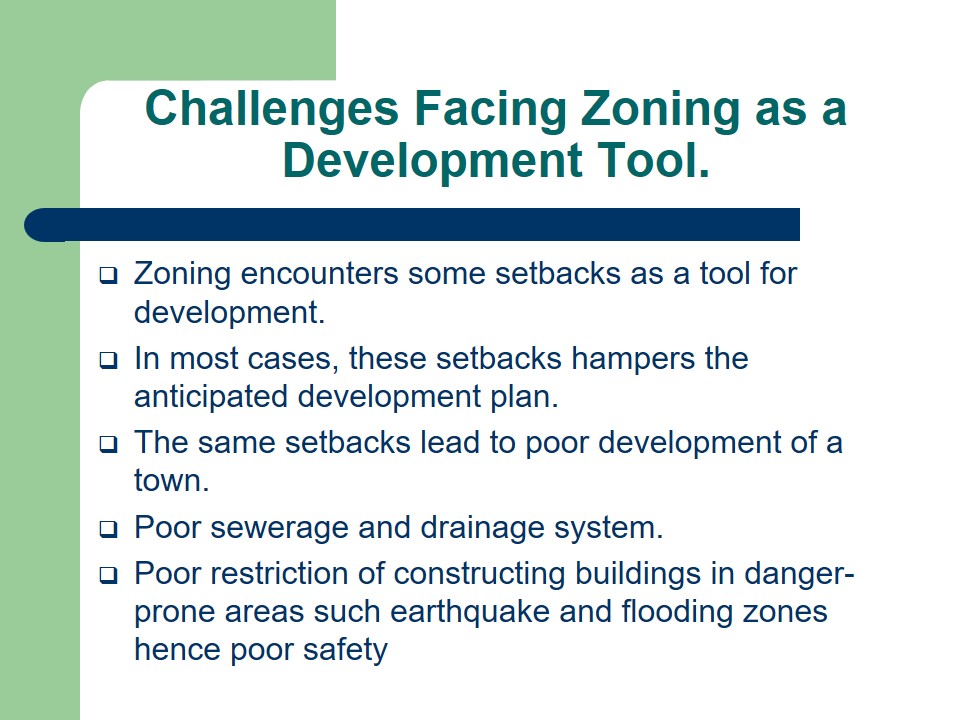
Legislation setbacks
- Zoning works alongside other legal amendments put in place to regulate land use.
- Such partners includes the land commission.
- It also faces legal challenges as it can only control private property regardless of ownership being real or rented.
Legislation setback are such rules set elsewhere on the land use regulation in the constitution and does not fall under the jurisdiction of zoning. Commissions which are legally recognized on land use regulations may jeopardize the performance of the zoning process in development.
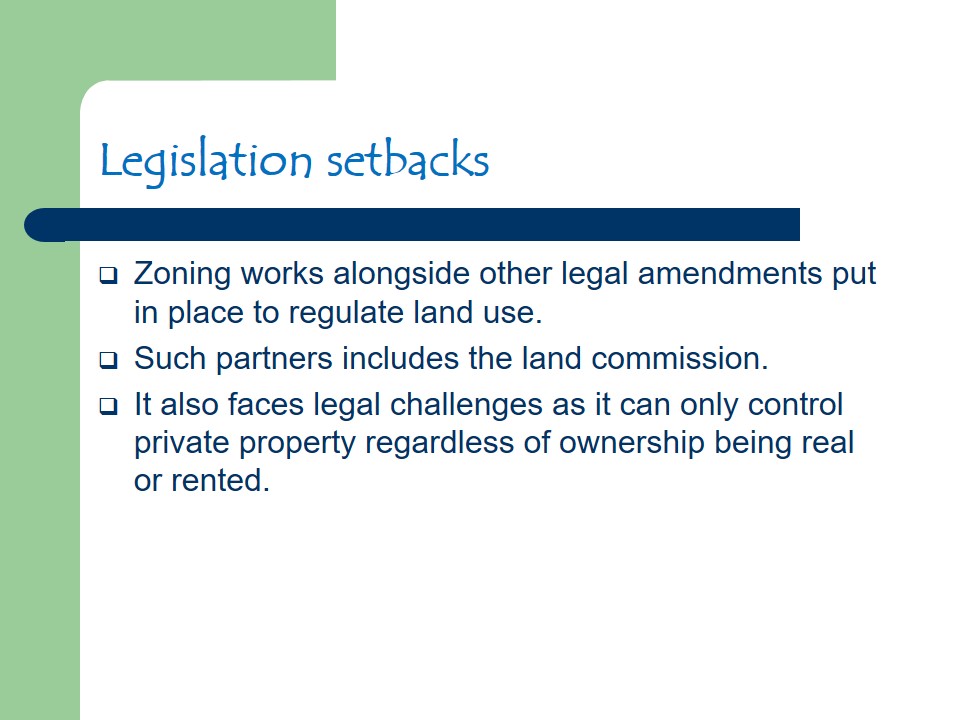
Nonconformities
- When a piece of land is zoned or rezoned, some legally existing structure may not conform to the new rules brought by zoning.
- Such nonconformities may involve usage, no conforming buildings among other requirements.
- When a structure is non conforming in terms of uses, it is difficult to change it due to its design specifications.
Nonconformities in originally existing structures which are legally valid, may not be forced to conform to the new zoning rules and thefore poor development in the region. The structures will remain in its state of design and use despite the new zoning rules.
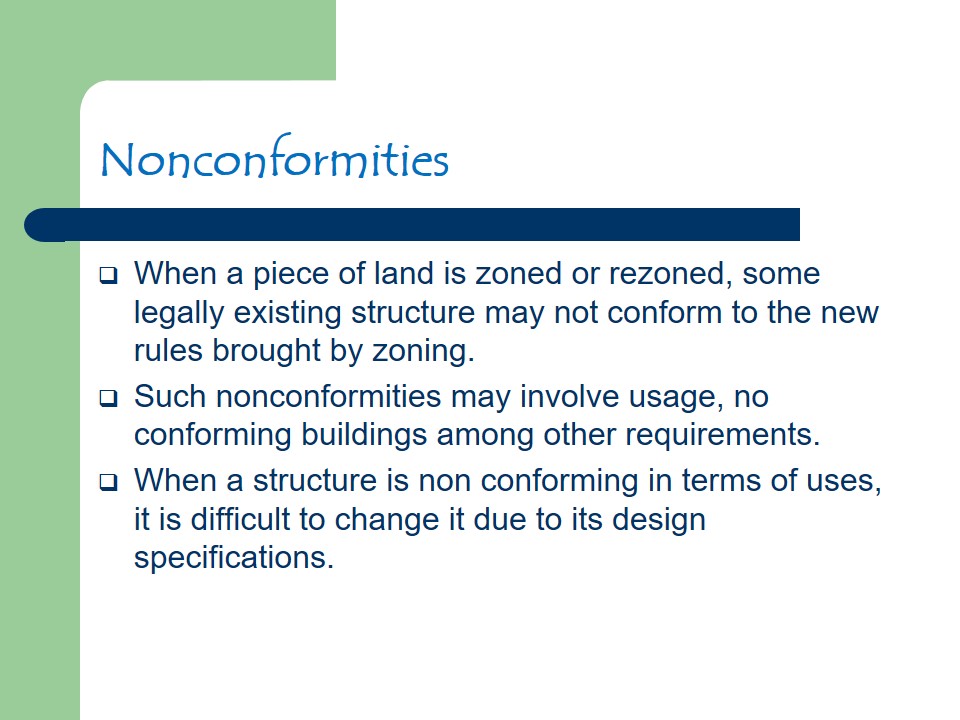
Conclusions
- Zoning is a major tool for urban development
- If zoning would be given a full authority over the control of land, at least much better results would be attained.
- However, zoning has been argued to contribute to urban sprawl.
- It also creates a fabric dominated by large parking spaces and wide streets.
- It also limits commercial competition by limiting available space for new ventures.
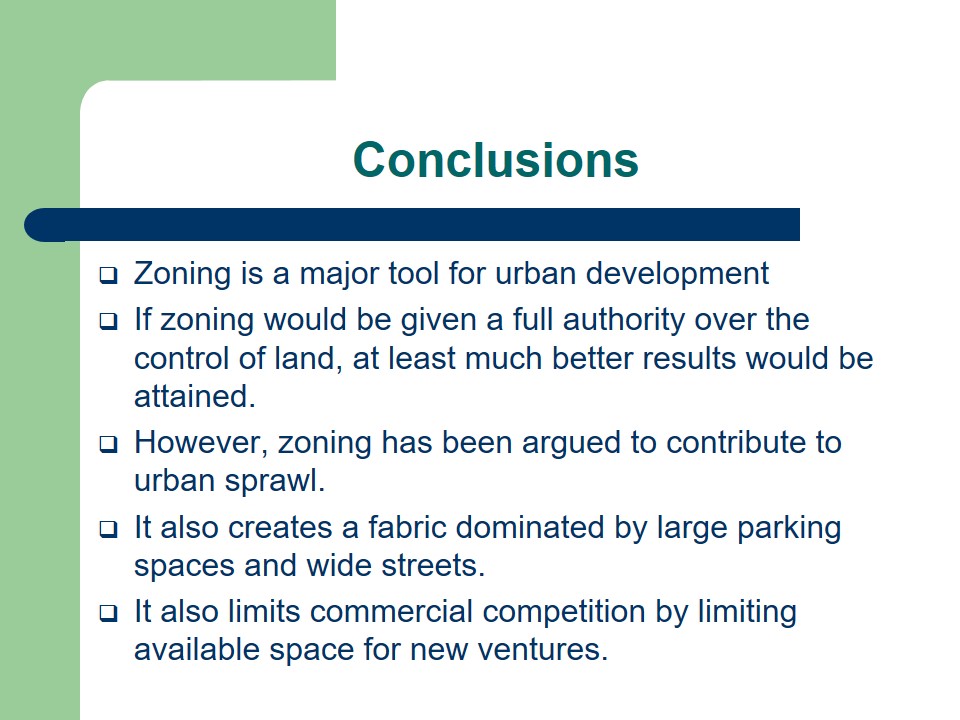
Works Cited
Burke, Barlow. Understanding the Law of Zoning and Land Use Controls, South Melbourne, Australia: LexisNexis Press, 2002. Print.
Walters, David. Designing Community, Charrettes, Masterplans and Form-based Codes, London: Thomson Learning, 2007. Print.